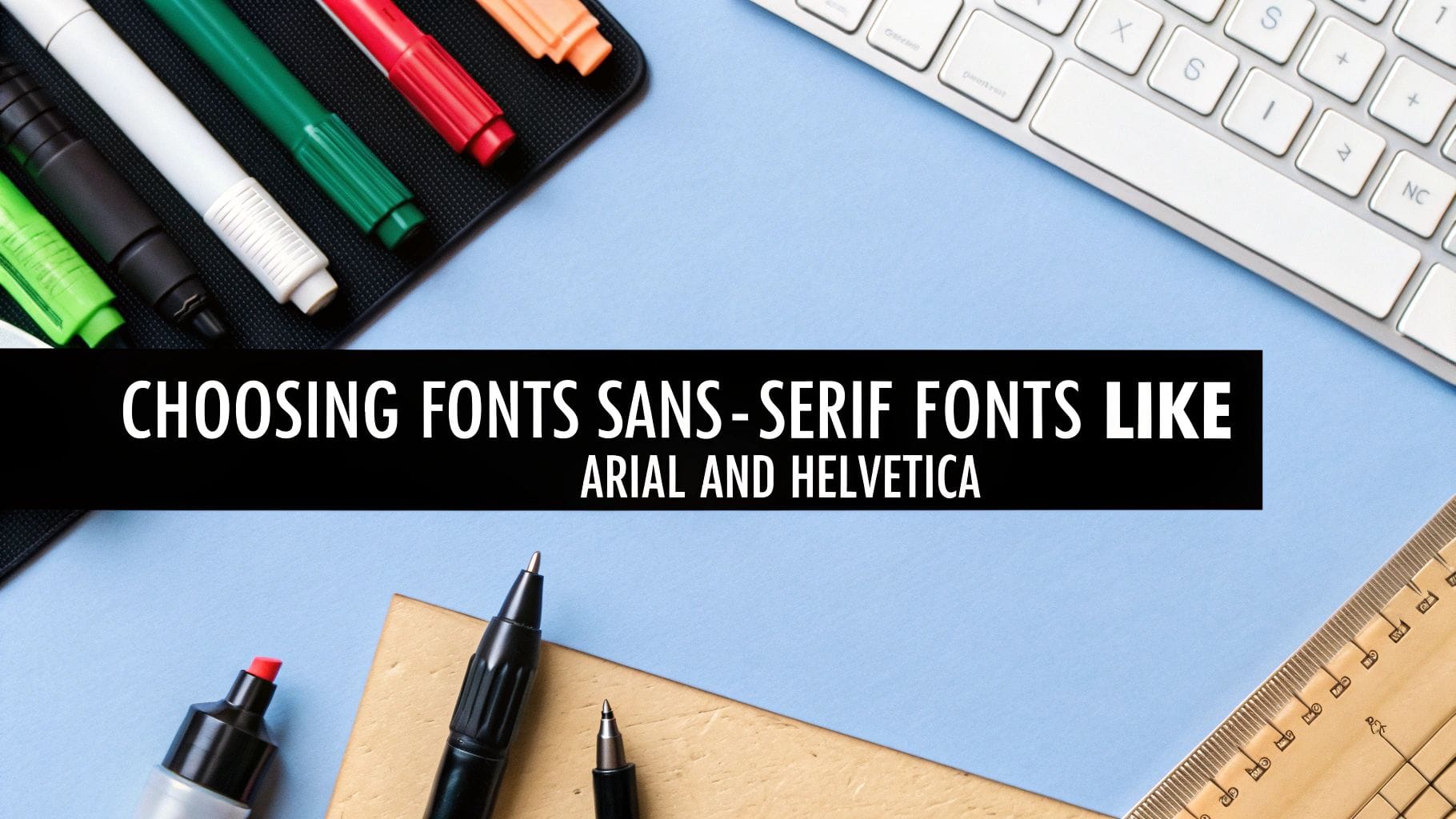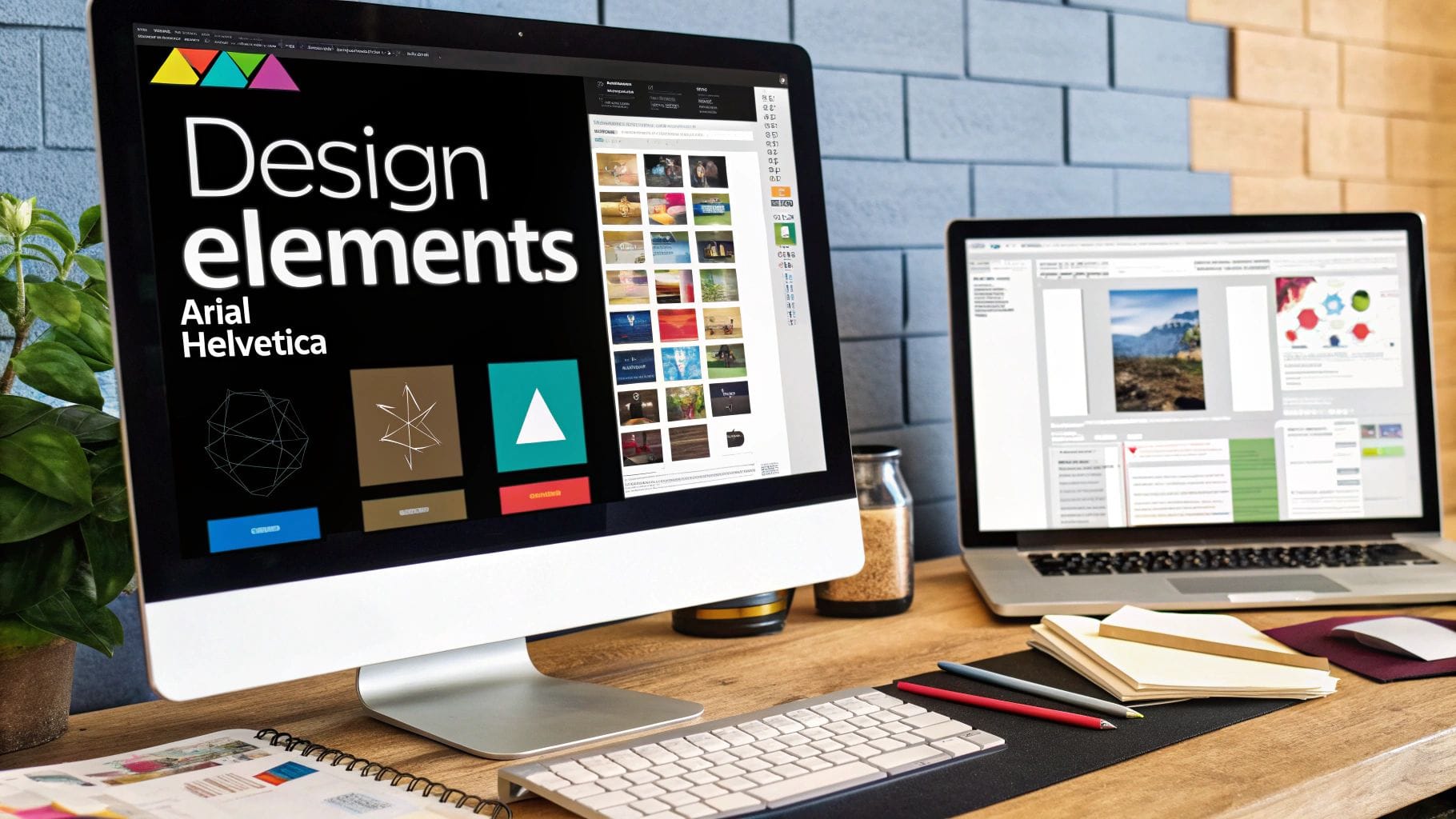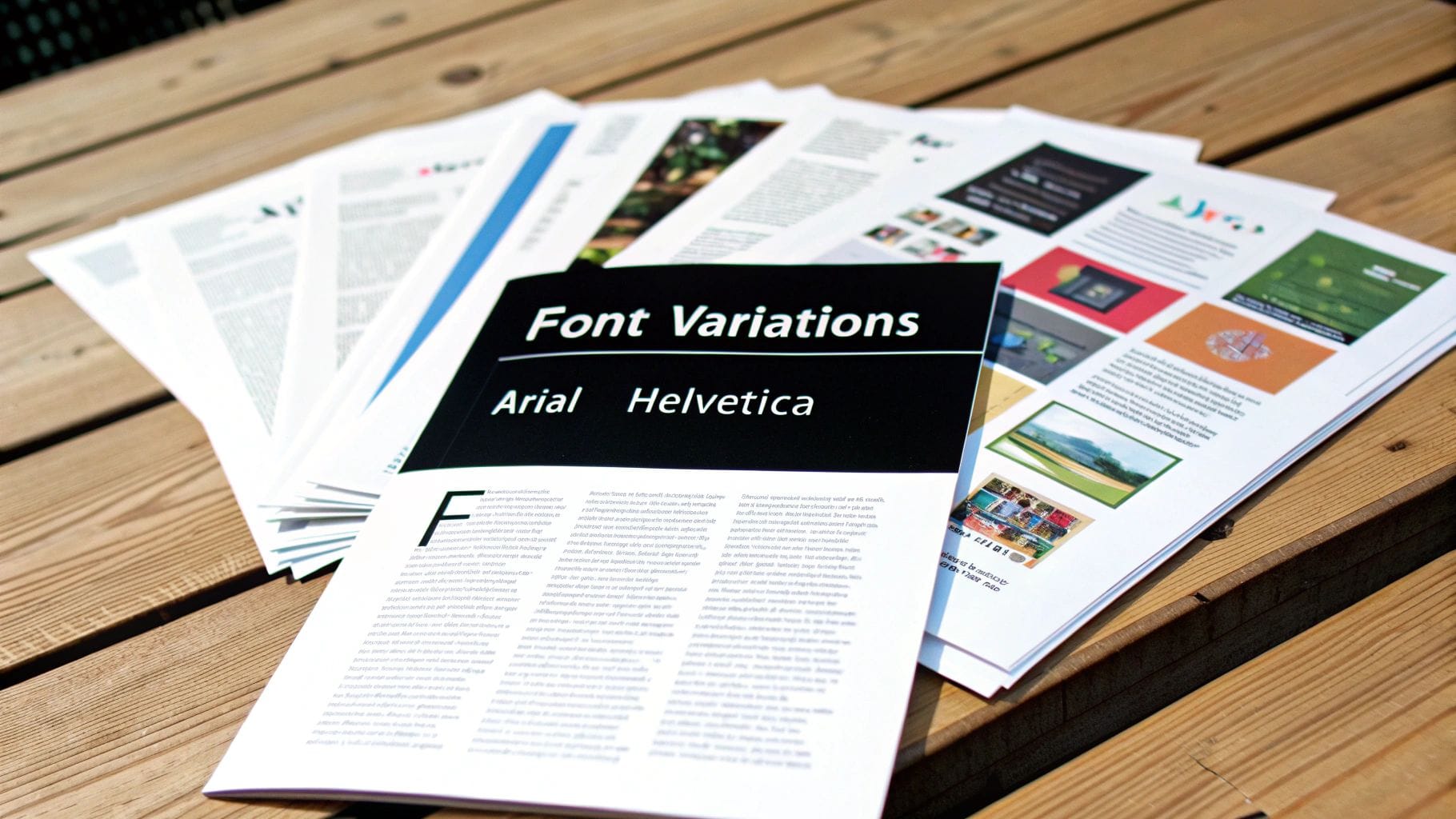Best Good Fonts for Newsletters: Transform Your Email Marketing Strategy
Best Good Fonts for Newsletters: Transform Your Email Marketing Strategy
Beyond Basic Typography: Why Fonts Make or Break Newsletters

The fonts you select for your newsletter do more than just look pretty - they directly affect how readers connect with your content and take action. Consider this: A recent Sprout24 study found that newsletters using sans-serif fonts like Arial and Helvetica had 1.2% higher click rates than those with serif fonts. While that may seem small, when measured across 500+ newsletters, it shows just how much typography shapes reader behavior and campaign success.
The Power of Perception: How Fonts Shape Your Brand
Different fonts trigger different emotional responses in readers. Serif fonts, with their decorative finishing strokes, signal tradition and authority - just look at how the New York Times uses them to project credibility. Sans-serif fonts feel clean and current, which is why tech companies often choose them. The key is picking fonts that match your brand's personality and what you want readers to feel when they see your newsletter in their inbox.
Readability and Engagement: Finding the Right Balance
A newsletter needs to be easy to read, or even the most beautiful design falls flat. That's where "email-safe" fonts come in - options like Arial, Verdana, Georgia and Times New Roman that display correctly across email platforms. For comfortable on-screen reading, stick to 14-16px font size for body text and leave enough space between lines to prevent eye strain. Remember, readability trumps style. You might be interested in: How to master email typography and choose the best fonts.
Strategic Font Pairing: Enhancing Visual Hierarchy
Using complementary fonts helps guide readers through your content. For example, pairing Georgia headers with Verdana body text creates visual contrast while keeping things clean and professional. Just don't go overboard - stick to two or three fonts max. Think of it like designing a webpage where each font has a clear purpose in directing attention and highlighting what matters most.
From Tradition to Innovation: Choosing Good Fonts For Newsletters
While email-safe fonts ensure your newsletter displays properly, web fonts offer more creative options for standing out. Just be sure to include fallback fonts in case the web font doesn't load. The most effective approach balances creativity with practicality - carefully consider your brand identity, target readers, and core message. When you thoughtfully select and combine fonts, you can craft newsletters that both look great and deliver real results through strong reader engagement.
Mastering Email-Safe Fonts That Actually Work

The fonts you choose for your newsletters directly impact how well your message comes across to readers. Beyond just looking good, your font choices need to work reliably across all devices and email clients. This means selecting "email-safe" fonts - those pre-installed on most systems that will display properly no matter how your subscribers view your newsletter.
Understanding the Basics of Email-Safe Fonts
Think of email-safe fonts as your newsletter's foundation. Common options like Arial, Verdana, Georgia, and Times New Roman work because they're already installed on most devices. Without these reliable fonts, your carefully designed newsletter could appear messy and unprofessional in subscribers' inboxes. For more guidance on picking the perfect font for your emails, check out our article on How to Master Email Typography and Choose the Best Fonts.
Exploring the Core Email-Safe Font Families
Email-safe fonts come in two main types: serif and sans-serif. Serif fonts like Times New Roman and Georgia feature small decorative strokes at the end of each letter. These classic touches make longer text sections easier to read and give content a more traditional feel. Sans-serif fonts such as Arial, Helvetica and Verdana skip the decorative elements for a cleaner, more modern look that works well in headlines and shorter sections. Your choice between these styles should match your brand's personality and the tone you want to set.
Best Practices for Using Email-Safe Fonts
Choosing the right fonts is just the start - you also need to use them effectively. Here's what to keep in mind:
- Font Pairing: Mix serif and sans-serif fonts to create visual interest and guide readers through your content. Try using serif fonts for body text and sans-serif for headings.
- Font Size: Make sure your text is easy to read by using 14-16px for body copy. This size works well across different screens and devices.
- Line Spacing: Give your text room to breathe with line spacing between 1.5 and 1.8 times your font size. This prevents crowding and makes reading more comfortable.
- Fallback Fonts: Always specify backup font options in case your first choice isn't available. This ensures your newsletter still looks good even if the primary font fails to load.
Following these guidelines helps create newsletters that look polished and professional on any device. When your fonts display reliably, readers can focus on your message rather than struggling with hard-to-read text. The result? Better engagement and a stronger connection with your audience.
Creating Perfect Font Combinations That Convert

When it comes to email newsletters, choosing and combining fonts is like putting together a well-balanced meal - each element needs to complement the others while serving its own purpose. The right font combinations do more than just look good - they make your content easy to read, guide readers through your message, and encourage them to take action.
Why Font Pairing Matters
Good font combinations create clear visual structure that helps readers quickly scan and understand your newsletter. When you pair fonts thoughtfully, you naturally highlight what's most important and make your content flow smoothly. For example, using Arial Black for headlines and Georgia for body text creates a clear distinction between different content types while keeping everything readable. These strategic font choices make it simple for readers to find key information and engage with your message.
The Art of Mixing Serif and Sans-Serif
Serif and sans-serif fonts each bring different qualities to your newsletter design. Serif fonts have small decorative strokes that give a traditional, established feel - perfect for longer text sections where readers need to stay focused. Sans-serif fonts feel clean and modern, making them great for headlines and short text blocks. But these aren't strict rules. Many newsletters, especially in tech and design fields, use sans-serif fonts throughout to create a contemporary look that matches their brand.
Creating Visual Hierarchy with Font Combinations
Think of your newsletter layout like organizing a room where everything has its place. Headlines act as signposts, guiding readers between sections. Body text provides the substance, while call-to-action buttons prompt engagement. Your font choices help define these roles clearly. Using a bold, prominent font for headlines naturally draws attention, while a comfortable reading font for body text lets readers easily absorb the details. This thoughtful organization keeps your newsletter from feeling cluttered and helps readers find what they need. Read also: The Best Email Newsletter Design: A Guide.
Examples of Effective Font Combinations
Heading Font | Body Font | Use Case |
|---|---|---|
Arial Black | Georgia | Corporate newsletters, announcements |
Helvetica | Verdana | Tech updates, product releases |
Playfair Display | Open Sans | Lifestyle blogs, promotional emails |
Montserrat | Lato | Design-focused content, creative agencies |
These combinations are just starting points - the best choice depends on your brand's personality and audience. Test different pairings to see what connects with your readers and drives engagement. Consider your newsletter's purpose too - promotional emails might need bolder fonts that grab attention, while regular updates work better with subtle, readable options. The goal is creating an inviting, easy-to-navigate experience that helps readers connect with your content and take action.
Choosing Fonts That Speak Your Brand Language
When it comes to newsletters, font selection goes far beyond just picking something that looks nice. Just like how your choice of clothing reflects your personal style, the fonts you use communicate your brand's personality to readers. Finding the right typography requires carefully considering your audience, matching fonts to your brand identity, and using them thoughtfully to create the most impact.
Defining Your Brand Personality Through Typography
Every font style sends a specific message. For example, traditional serif fonts like Times New Roman project authority and professionalism - it's no accident that prestigious newspapers like the New York Times use them. On the flip side, modern sans-serif fonts like Arial feel clean and current, which is why many tech companies favor them. The key is picking fonts that match who you are as a brand. Do you want to come across as polished and established? Fun and approachable? Your font choices should reflect that personality.
Aligning Font Choices With Audience Expectations
Your font selections need to resonate with the people reading your newsletter, not just match your brand. For instance, if you're writing for a younger crowd, sleek geometric sans-serif fonts tend to work well. But for a professional audience, readable serif fonts often feel more appropriate. Making these thoughtful choices helps readers connect with your content naturally. There's data to back this up too - a Sprout24 study found newsletters using sans-serif fonts saw 1.2% higher click rates, showing how font choice directly impacts engagement.
Building a Cohesive Brand Identity With Strategic Font Pairing
While sticking to email-safe fonts ensures consistent display, smart font combinations can create a distinctive look. For example, using a serif font for headlines with a sans-serif for body text adds visual interest while keeping things readable. But don't go overboard - like wearing too many patterns at once, using too many fonts gets messy fast. Stick to 2-3 carefully chosen options, each serving a clear purpose in your design. Check out our guide on the importance of newsletter branding for more tips.
Avoiding Common Font Selection Mistakes
Even with solid brand and audience understanding, it's easy to make font missteps. One frequent error is choosing fonts that look cool but are hard to read - which defeats the purpose of your newsletter entirely. Another common problem is cramming text too tightly together, creating dense blocks that turn readers away. Following basic guidelines like using 14-16px font size and proper spacing helps create an inviting reading experience that keeps people engaged with your content.
Fine-Tuning Your Font Strategy for Maximum Impact
Selecting the right fonts is just the first step in creating an engaging newsletter. To make your fonts truly work for you, you need to consider how they function together as part of your overall design. Let's explore how to optimize spacing, sizing, contrast, and visual structure to create newsletters that are both beautiful and easy to read.
The Importance of Spacing and Sizing
Think of your newsletter layout like arranging furniture in a room - every element needs the right amount of space to function well. When text is crammed together, it becomes difficult to read, just like a cluttered room feels uncomfortable to navigate. For optimal readability, set your line spacing (leading) between 1.5 and 1.8 times your font size. This gives your text room to breathe while maintaining a natural reading flow.
Font size matters just as much as spacing. Text that's too small strains the eyes, while oversized text can look unprofessional. For body copy that works well across devices, stick to 14-16px. This size hits the sweet spot between readability and professional appearance.
Creating Contrast for Readability
Good contrast helps readers move smoothly through your content while highlighting what matters most. This goes beyond just pairing different font families - though that's important too. Consider using varied weights and colors to create clear visual distinctions. For example, bold headlines paired with regular-weight body text naturally guide readers through your content structure.
Dark text on a light background (or vice versa) makes reading easier and reduces eye strain. When your text stands out clearly from its background, readers can focus on your message rather than struggling to make out the words.
Establishing Visual Hierarchy for Engagement
A clear visual hierarchy works like a roadmap, guiding readers through your content in a logical order. By thoughtfully varying font sizes, weights, and styles, you create natural stopping points that help readers process information in chunks.
Start with a prominent headline that catches attention, then use progressively smaller subheadings to break up sections. Make your call-to-action buttons visually distinct so they pop from the page. When readers can quickly scan and understand your layout, they're more likely to stay engaged with your content.
Testing and Refining Your Font Strategy
Creating an effective font strategy is an ongoing process that benefits from regular testing and adjustment. Just as you might A/B test subject lines, try experimenting with different font combinations and spacing to see what resonates with your audience.
Pay attention to metrics like open rates, click-throughs, and time spent reading to understand how your choices impact engagement. This data-driven approach helps you develop newsletters that don't just look good but also achieve your communication goals. Small tweaks to your font strategy can make a big difference in how effectively your newsletters connect with readers.
Measuring What Matters: Font Performance Analytics
Making small adjustments to your fonts can significantly impact your newsletter's success rates. But selecting good fonts alone isn't enough - you need data to understand how they perform with your specific audience. By moving beyond personal preferences and aesthetics into measurable results, you can make informed decisions about which fonts truly resonate.
Setting Up Meaningful A/B Tests for Fonts
A/B testing gives you concrete data about what works best. Just like testing different subject lines or layouts, you can compare how different font combinations perform in your newsletters. For instance, send half your subscribers a version using Arial for body text and the other half a version with Georgia, while keeping all other elements identical. This isolates the specific impact of font choice.
To get even more valuable insights, segment your audience when testing fonts. Your younger subscribers may prefer clean sans-serif fonts, while older readers gravitate toward familiar serif options. By analyzing results across different demographic groups, you'll understand which fonts work best for each segment of your audience.
Tracking the Right Metrics: Beyond Open Rates
While open rates provide useful data, they don't tell the complete story of font performance. Focus on metrics that show real engagement - click-through rates, time spent reading, and conversion rates. When readers click links and spend time consuming your content, it indicates the fonts are supporting a positive reading experience. If you notice declining engagement after switching fonts, it may signal readability issues. You might be interested in: How to master email marketing with proven tips and strategies.
Maintaining Brand Consistency While Optimizing Fonts
Using data to improve performance doesn't mean abandoning your brand identity. As you analyze font metrics, ensure your choices still align with your overall visual style and personality. For example, if your brand has a modern, minimal aesthetic, an ornate serif font may clash even if it shows slightly better test results. The goal is finding fonts that both perform well and maintain brand consistency.
Real-World Examples and Frameworks for Ongoing Optimization
Even minor font adjustments can meaningfully boost engagement. A Sprout24 study of over 500 newsletters found that using sans-serif fonts like Arial and Helvetica increased click-through rates by 1.2% compared to serif fonts. This shows how font selection directly impacts reader behavior. To sustain results over time, create a system for regular font testing and optimization. Monitor key metrics consistently, run A/B tests, and stay current with typography trends. This ongoing refinement ensures your newsletters remain visually appealing and effective at achieving your goals.
Ready to elevate your newsletter's performance and captivate your audience with stunning visuals and engaging content? Inagiffy offers an end-to-end newsletter service that handles everything from server optimization and domain warming to branding and content creation. We take care of the technical details so you can focus on connecting with your readers. Visit inagiffy.news today to learn more and transform your email marketing strategy.
Comments
Your comment has been submitted successfully!